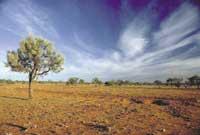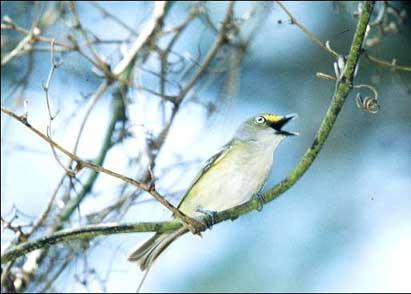A surprising life in the deserts
2000/12/24 Mendiburu, Joana - Elhuyar Zientziaren Komunikazioa
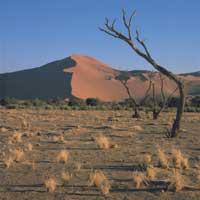
All deserts are characterized by a lack of water. The land that receives less than 250 mm of rain per year is understood as desert, but to measure aridity, one must take into account the temperature and frequency of the knife, which are responsible for the evaporation. The second factor to mention when talking about deserts is the temperature as important as water. In fact, although we often relate deserts to heat, some deserts are very cold. Here we will only mention the warm deserts, since in cold deserts there is hardly any life. However, if so far we have had the desert as a homogeneous ecosystem, it is increasingly clear that within a desert there can be many microclimates that change each year.
The continental drift and the creation of mountain ranges have been modifying the location of deserts. The current deserts are located at latitudes between 15º and 30º to the north and south of the equator and around the tropics of Cancer and Capricorn (see map).
Plant Strategies Vegetable Strategies
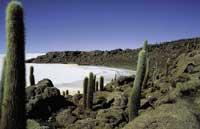
To cope with the harsh life in the deserts, plants and animals have had to develop a strategic life. In the deserts you can find a multitude of surprising techniques to make the most of the water and avoid heat.
Desert plants have undergone physical and behavioral changes to adapt to extreme heat and aridity. To reduce the sweating area, photosynthesis is done, instead of the leaves, stems and adapted branches. Thus, these plants have no drawback in reducing the number of leaves or converting them into thorns. The latter are also defense against phytophages. In addition, to absorb the carbon dioxide necessary for photosynthesis, some plants open the stomach only at night, when the water loss is lower. The roots are also adapted to aridity. To absorb as much water as possible during the rain, they are usually very extensive and shallow. The best known plant adapted to this situation is cactus.
Another anti-lasting strategy is the development of long and deep roots. The pumpkin that appears in the sandy deserts, for example, has roots of 40 meters in length. There are plants that combine different strategies. For example, the plant called Creosote has two types of deep and superficial roots to absorb water from every corner.
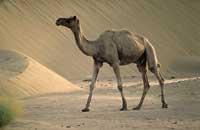
Finally, some plants prefer to escape rather than to resist thaw. In times of prolonged drought, waiting for rain, they fall asleep and hide. After each intense rain, with an unbeatable speed, they grow and bloom. At this time its main task is to disperse the seeds so that the species lasts. At the time when drought once again prevails, the desert returns to its ancient hidden life.
Animals also their techniques
Aridity is hard for all the inhabitants of the desert, but animals can have more problems than plants, since they receive heat not only from solar radiation, but also from substrate. However, unlike plants, animals can move and, of course, that's a great advantage. Larger animals, such as camels, dogs or elephants, in search of water and shade, go through oases and wells, but for smaller animals it is impossible to walk like this. Therefore, to overcome the excess heat, many snakes, rodents and mammals have become nocturnal. During the day they hide in caves and shelters until the enjoyment of the temperature. The birds, on the other hand, cannot do so and use another technique to refresh a little. They are oriented towards the sky, after opening the mouth and expiring, to recover the water that evaporates, with a surprising speed, they turn on the evaporated water. Some mammals, such as fen, have developed extensions to disperse body heat.
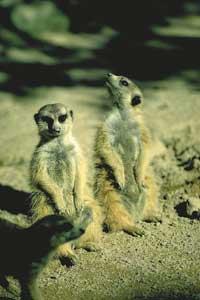
On the other hand, many desert animals have taken the substrate color to absorb less heat and that predators are not so easily recognizable. However, there are dark animals like the black vulture. This vulture uses urine to reduce the heat it absorbs. Make the urine on the leg, so that it can cool the blood that is dispersed throughout the body.
Each one gets in his way to calm the extreme temperatures, but that is not enough, we must also face the scarcity of water. The main water absorbers are the plants, which in addition to having the proper roots, have the ability to collect water from the fog and dew. Most of the animals get water from food and insects from plants and birds and reptiles from insects. However, the water they achieve thus is not always sufficient for all animals and have developed many special techniques. For example, some mammals cover the hole that passes the day to maintain the humidity that comes from the airways and recover it through specialized organs. Some reptiles, thanks to microscopic tubes they have in the kidneys, recover part of the water from the urine and redirect it to the blood. Thus, reptiles and birds make a much more concentrated urine, reducing the loss of water.
They are just a few examples of the real complexity of these vast arid areas that appear sparsely inhabited. To deal with the increasingly serious shortage of water for us, perhaps we all have to learn from all these techniques
Published in the supplement Natura de Gara

Gai honi buruzko eduki gehiago
Elhuyarrek garatutako teknologia




